
You’ve probably heard about the cache plugin if you run a blog or an online business. But do you know why it is essential to use a cache plugin and how it can help? In this blog post, I will teach you how to configure the Breeze cache plugin developed by Cloudways Hosting.
As you know, website speed is one of the most important ranking factors, and if your site takes more than three seconds to load, your visitors will leave. It may lead you to frustration as you lose potential sales and subscribers.
The cache plugin plays a vital role in improving the speed of a website/ blog. It creates static HTML pages for your website and stores them on the server. When a user visits your site, the server directly serves it. In this way, a heavier website becomes lighter and loads quickly.
Many cache plugins are available on the market, but most are quite expensive. Fortunately, the Breeze cache plugin is here to speed up our site. As we use Cloudways hosting for our blog, we have decided to write about its settings and configuration to help you easily set up the plugin.
Now, let me tell you how to optimize your blog or website using the best Breeze caching plugin settings. Before getting into the setup options, I would like to explain the best features of this WordPress cache plugin. Let’s get started!
Breeze cache plugin overview
Breeze cache plugin is yet simple and powerful WordPress caching plugin available with all Cloudways hosting accounts, but it can also be used with other hosting service providers. With Breeze, you can improve the speed of your WordPress website with its amazing features.
For example, it uses internal caching to improve the page loading speed so that the viewer doesn’t have to wait long to see your content. It also optimizes databases by removing unwanted or repetitive data to optimize query processing time.
Best Features Of Breeze Plugin
Now, let’s take a deeper look at the features of the Breeze Cache plugin so that you would like to install it on your WordPress site.
1. Optimized for Cloudways hosting
The Breeze cache plugin is developed by Cloudways hosting, so it is obvious that this cache plugin works best with websites hosted by Cloudways hosting.
Although it is a free plugin, it outperforms some of the best premium cache plugins, like WPRocket and WP Fastest cache, when used with a Cloudways account.
2. Ease of use
The plugin’s user interface is beginner-friendly and pretty easy to set up. You don’t need to worry about changing many settings to make it work better.
You can install and set up Breeze with a few clicks, and the plugin will handle the rest of the work.
3. Compatibility with Varnish cache
Breeze cache plugin works with Varnish cache, one of the best HTTP accelerators available on the market, to make your website faster.
If you use Cloudways hosting to host your website, Varnish comes pre-installed. So all you need to do is install the Breeze plugin, and you are good to go.
4. WordPress multisite compatibility
The Breeze cache plugin is compatible with WordPress multisite. So you will not face a problem in setting up Breeze even if you have multiple websites under a single WordPress dashboard. You don’t need any additional configuration.
5. WooCommerce compatibility
WooCommerce is a popular WordPress plugin that is used by most e-commerce websites. Breeze cache works perfectly with WooCommerce websites. You don’t need to do any extra setup for that.
6. CDN support
CDNs or content delivery networks are servers that help speed up data transmission between clients and web servers. Breeze uses CDN to enhance the speed of the websites. With a CDN, websites with images and video can load very fast.
Another advantage of CDN is that you can accelerate the website speed even in remote areas using the network of servers.
7. Minification
Minification is the process of optimizing your codebase to improve the performance and speed of the website. It also reduces the bandwidth used by the website.
Although the minification is not the best-in-class for Breeze cache, you will get satisfactory results with simpler sites. You can also use other plugins like Autoptimize to do the minification.
8. Gzip compression
With Breeze, you can use Gzip compression to compress the size of your HTML, CSS, and JS files to improve the performance of your website. You can compress your code files with just one click.
9. Database optimization
Breeze cache optimizes the database to speed up the query processing process, which is great for getting faster results from the server. It cleans up drafted and repeated content, posts revisions, and trackbacks to make the database cleaner and more optimized.
10. It’s FREE
The Breeze cache plugin is absolutely free of cost! No, I am not talking about having a free tier with limited functionalities. You can use all the features of the Breeze cache plugin without spending a penny, unlike other “freemium” cache plugins offering only basic cache functions with their free plans.
How To Install Breeze Cache Plugin?
Breeze cache plugin installation is fairly simple and straightforward. You need to go to the plugins section of your WordPress dashboard.
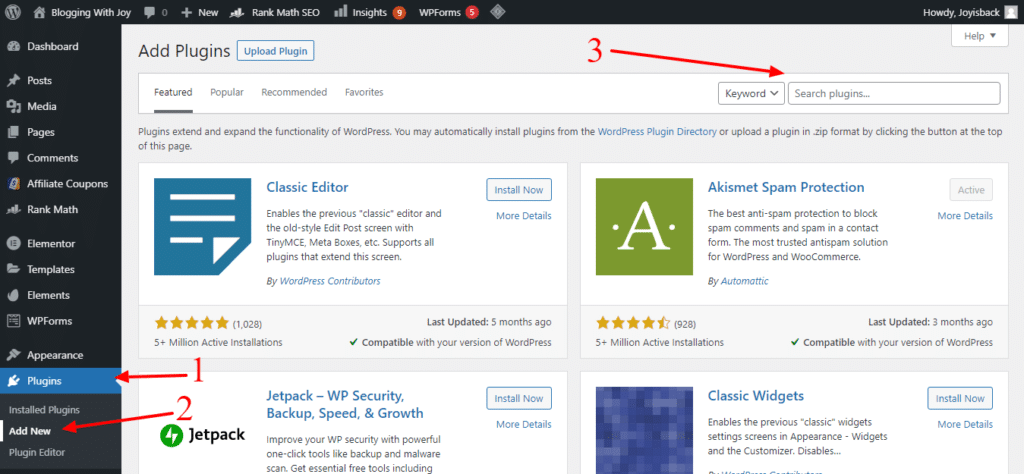
Search for “Breeze cache” in the search box.
After the Breeze cache appears in the search results, click Install Now.
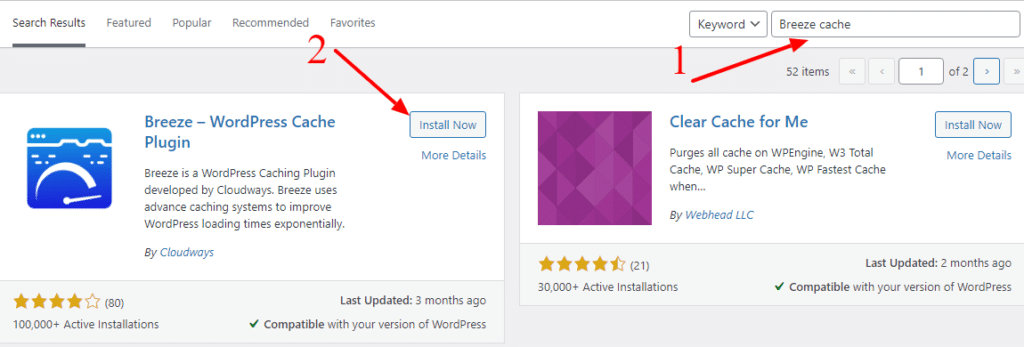
After the installation process is complete, you have to activate the plugin by clicking on Active.

How to Set Up the Breeze WordPress plugin?
There is no need to worry about setting up this extension as Breeze handles all the setup. However, there are a few tunings that I would recommend you make through this tutorial, such as how to configure the Breeze cache plugin.
- Activate the cache system.
- Disable minification as the minification tool for Breeze is not that good. You can use a separate plugin for this purpose.
- Enable Gzip compression.
- Enable browser cache.
Minify, Group, and Exclude Files with Breeze Cache
Minification is the process of optimizing your HTML, CSS, and JS files by removing unnecessary parts of the codebase without tampering with its functionality. This process greatly benefits the loading time of the webpage, making it faster. It also decreases the bandwidth required by the page.
With Breeze cache, you can minify your codebase to make your website faster and more efficient. Just go to Breeze and click on File Optimization, and you will see the option to minify all the components of your codebase.
You get the option to minify HTML, CSS, JS, and inline CSS/JS. You can begin by minifying all the components by turning on all the required settings.
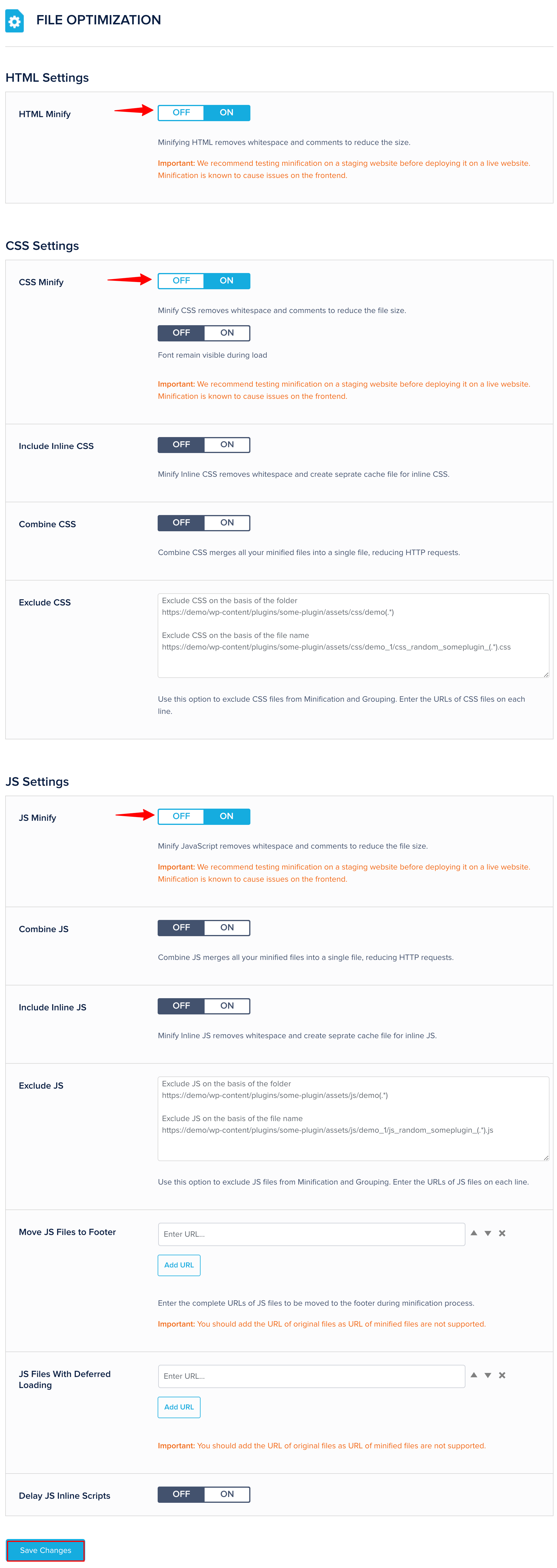
Later, if you face any problem with your website due to minification, you can disable minification for some components at your convenience.
Not only that, if the minification of a specific CSS/JS file hampers some functionality of your website, you can exclude that file from being minified.
To exclude some files from being minified, go to the ADVANCED OPTIONS section of the settings, and you will get to see two boxes where you can put the URL of the respective files to exclude them.
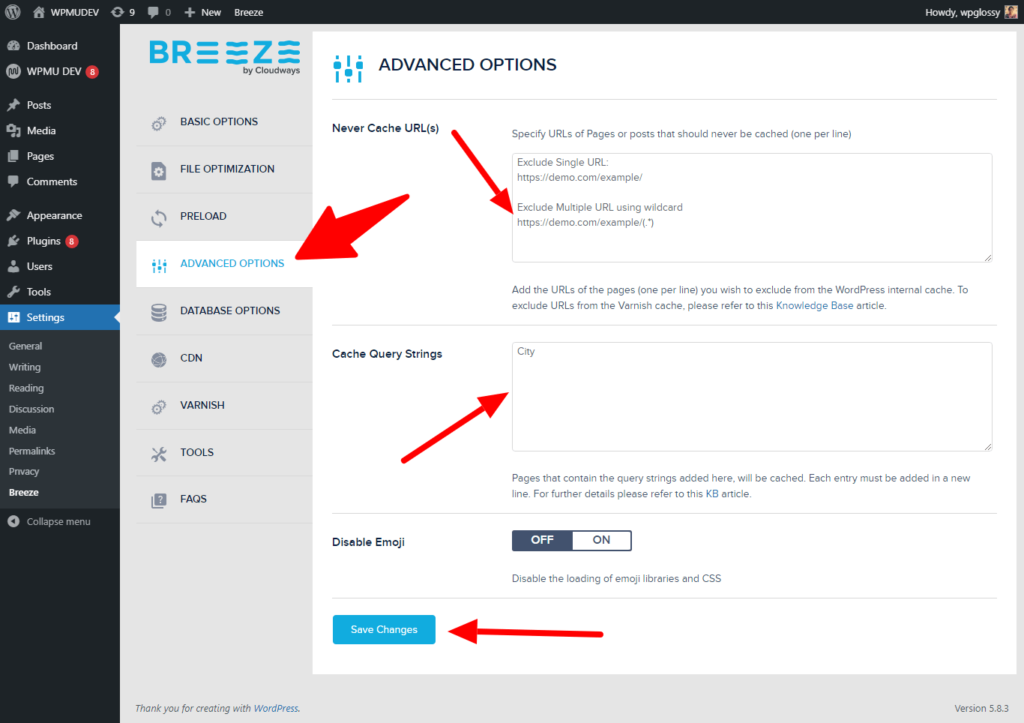
Another great way to improve data transmission speed and the website’s loading time is to use Gzip compression. Compressing your codebase and media files makes HTTP requests faster and more efficient. To enable Gzip compression in Breeze cache, go to BASIC OPTIONS and check the box next to Gzip Compression.
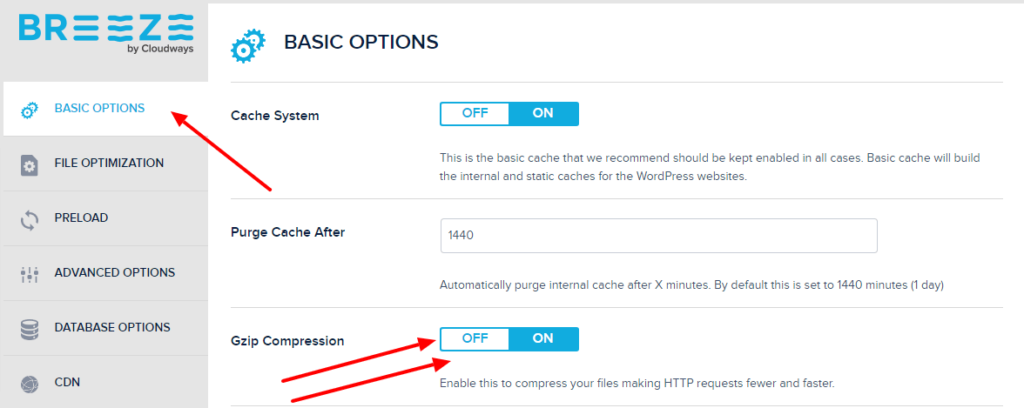
Also, in the File Optimization section, you get two more settings that you can use to optimize your site performance. First, using the Move JS files to the footer option, you can move the JS files to the footer section from the header to improve load time. You also get the option to execute a specific JS file after loading a page using JS files with deferred loading.

Caching With Breeze – Internal and Varnish
Now comes the main functionality of the Breeze plugin i.e. caching. In the BASIC OPTIONS section of the settings, you can enable the Cache System option to build an internal and static cache for your website.

Below that, you will get the option to automatically delete/purge the cached content after a certain time interval. You can also enable browser caching by enabling the options available at the end of the menu.

Activating the preload function will also improve the speed of your website. For best performance, optimize the URL, which consists only of fonts. Go to the Preload option and add your URL in the Preload WebFont section.
Also, you can easily optimize your website url with the help of the Breeze cache plugin. When you enable Preload links, it will create a cache of any link when hovered over. This will make the page load faster.
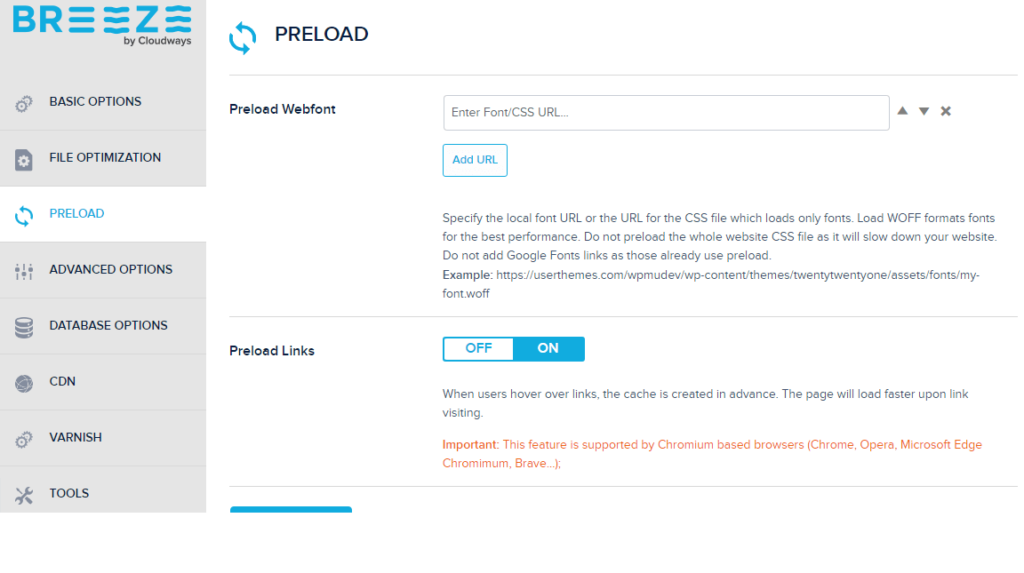
Another thing to remember is that you need to install Varnish cache to get the best out of Breeze. If your website is hosted on Cloudways, it is not a problem as Varnish comes pre-installed with the Cloudways servers.
If you are not a Cloudways user, you need to install Varnish cache and place the proper IP of the server in the VARNISH section of the settings (For Cloudways users, the IP is given by default).
For the Varnish cache, you can also enable the Auto Purge Varnish option to clear the cache after a specific interval, or you can do that manually by clicking on the Purge option next to the Purge Varnish cache section.
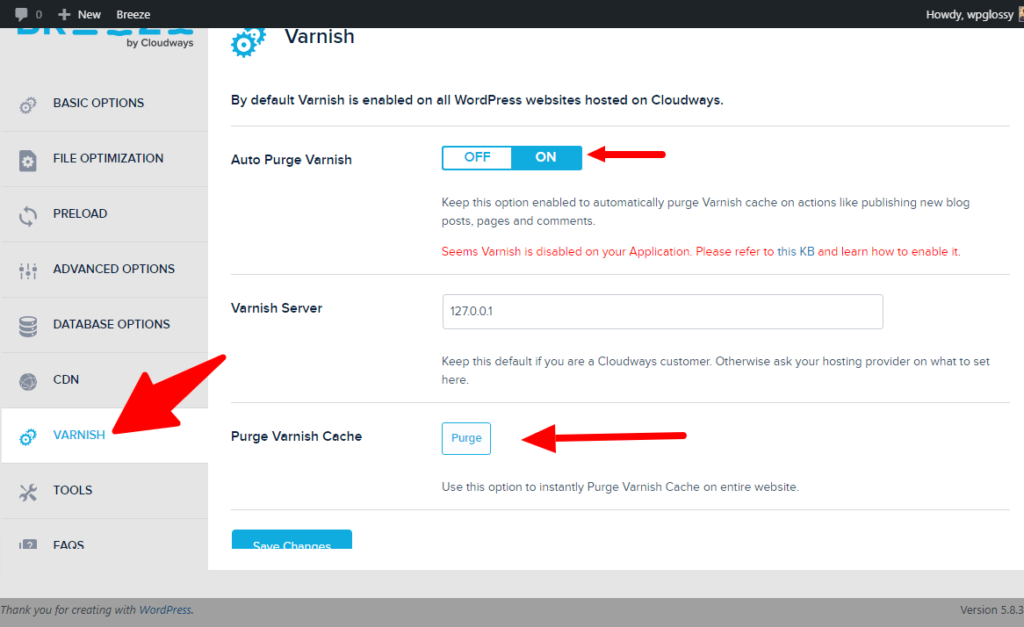
In the advanced section, you also get an option to mark the pages that you don’t need to cache. This feature can be accessed by providing the respective URL of the pages in the Never Cache These URLs section.

Integration between CDN and Breeze:
Breeze cache uses CDN to improve the speed of heavy websites with multiple media files. It only takes a few minutes to complete the CDN integration with the cache plugin.
Visit the CDN section of the settings and at the top, you will see the option to activate the CDN. After that, you will come across the CDN CNAME section, where you have to enter the hostname URL provided by the CDN provider.
The format for entering the URL is already stated in the box below. E.g., if your website contains a combination of HTTP and HTTPS content, you need to put ‘//’ in front of the URL (as in //cdn.mysite.com)
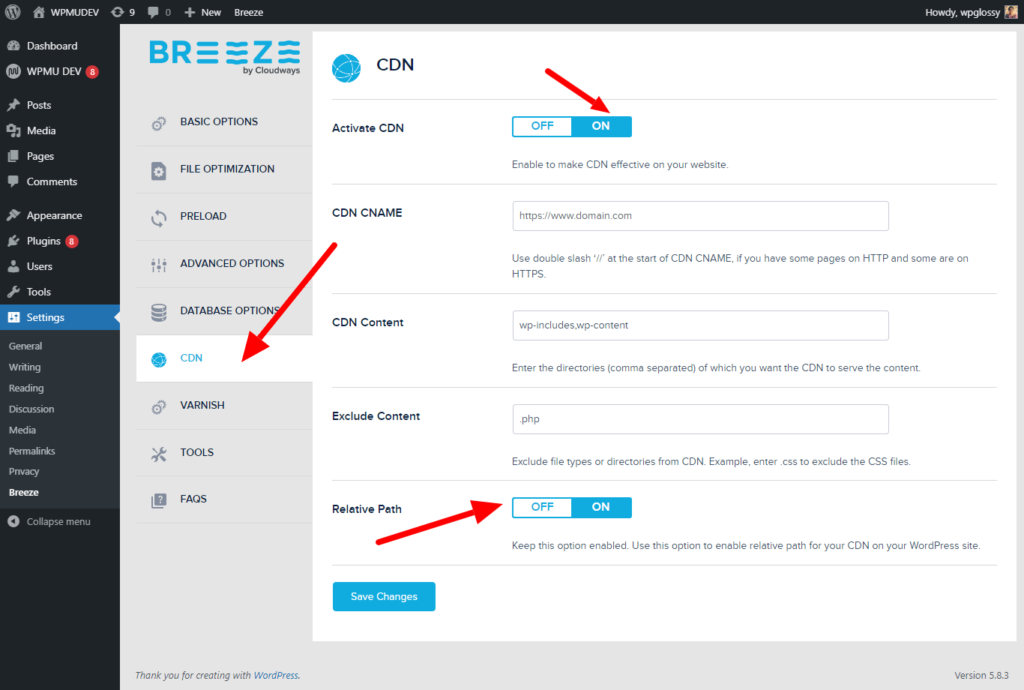
Below that, in the CDN Content section, you get to select specific directories for the CDN to serve, and you can exclude files with specific extensions in the Exclude Content section. You will then see the Relative Path option, which should be enabled.
You need to keep in mind is that Breeze only supports Pull CDN services like CloudwaysCDN, Amazon CloudFront, StackPath, etc.
Optimize Your Database with Breeze
A clean and concise database is beneficial for decreasing query processing time. In the DATABASE section of the settings, Breeze provides options to optimize your WordPress database to make it look cleaner.
You will see options to delete auto-drafted content, post revisions, trashed content, unnecessary comments, trackbacks & pingbacks, and transient options to make your database more optimized.
You can optimize your database with just one click: Check the clean all option and then click on Clean now.
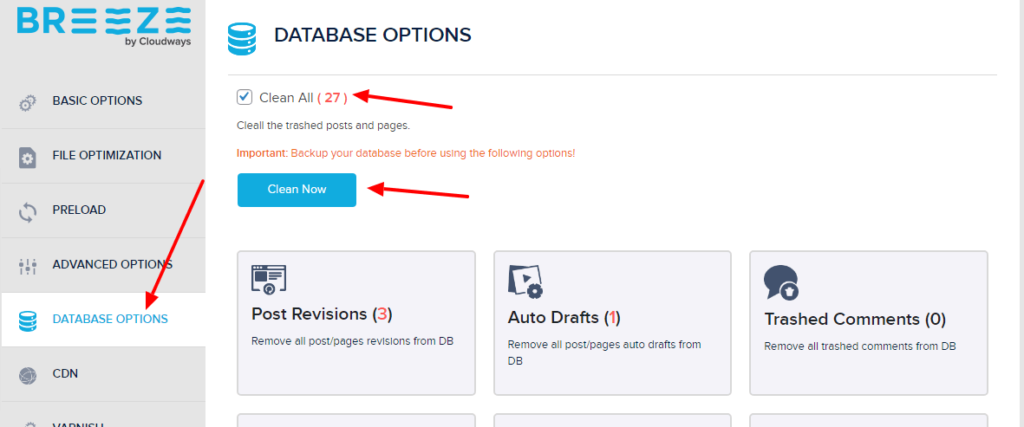
To clean the database manually, select all the options you want to clean and click on Optimize.
I selected the following options: Post Revisions, Autodraft, Trashed Comments
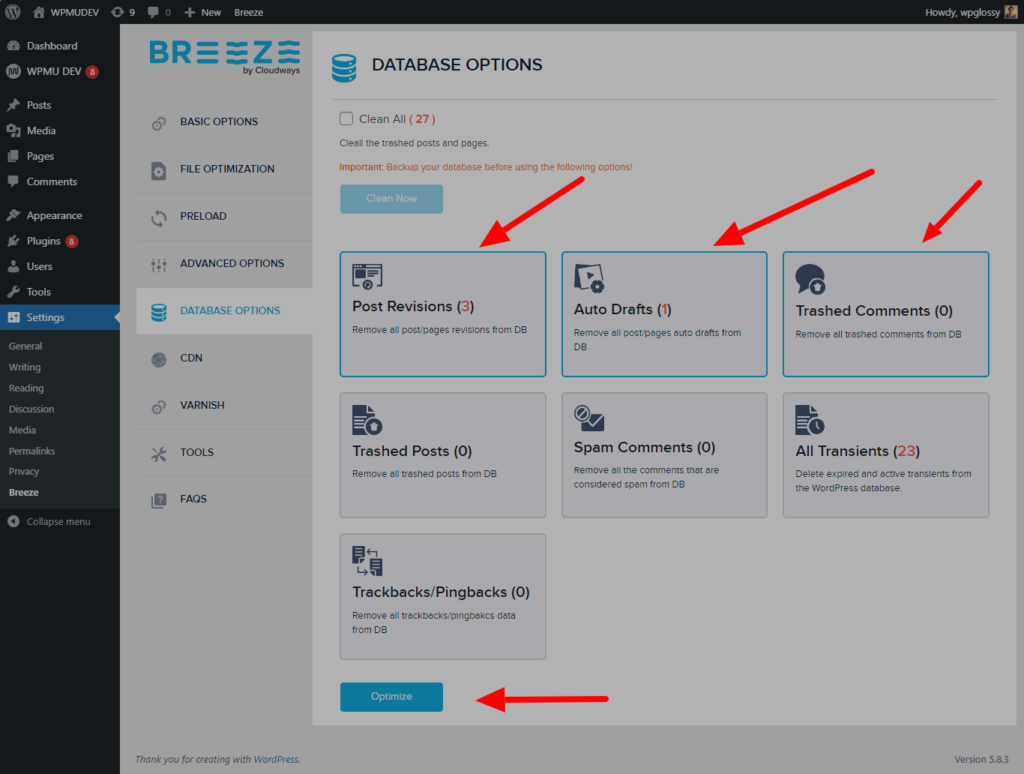
Wrapping Up
I have explained how to configure the Breeze Cache plugin; I hope this content will help you understand its exceptional qualities that could make your site load fast.
This WordPress plugin has been recently updated with the easy ON/OFF buttons in the settings, which you can see in the screenshots above.
So, are you clear with the features and setting choices of the Breeze plugin? Which cache plugin have you installed on your website? Would you like to use this cache plugin by Cloudways?
